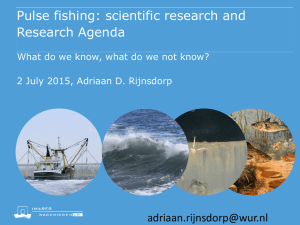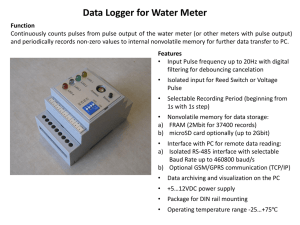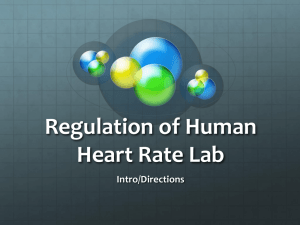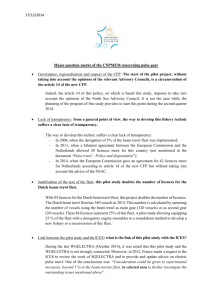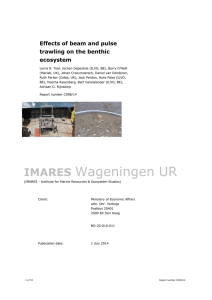IMARES Pulsetrawl NSAC IJmuiden 17112014
advertisement
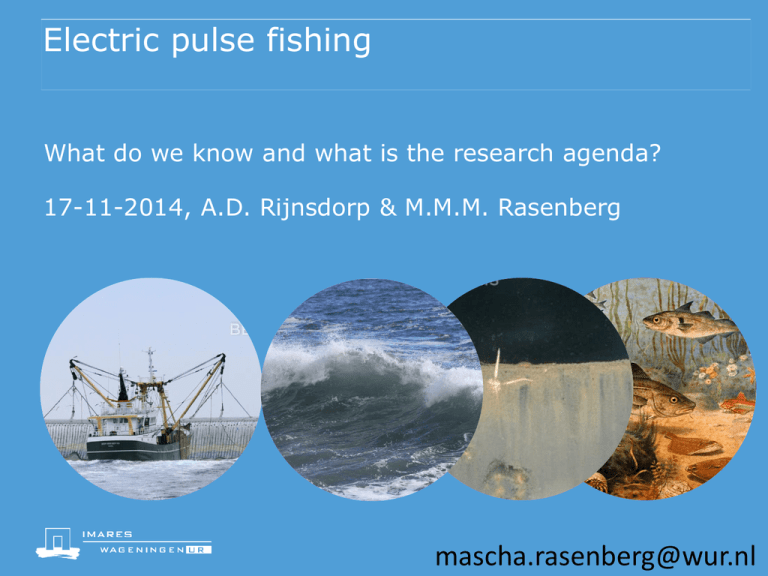
Electric pulse fishing What do we know and what is the research agenda? 17-11-2014, A.D. Rijnsdorp & M.M.M. Rasenberg mascha.rasenberg@wur.nl Introduction Background Beam trawl fishery for flatfish (sole & plaice) ● Tickler chain impact on sea bed and benthos ● Small mesh large bycatch of undersized fish ● High fuel cost (heavy gear and high towing speed) Pulse trawl ● Since 2009 based on temporary licences ● Indications of an increase of sole catches & decrease bycatch (fish and benthos) ● Reduction in fuel costs: about 50% (lighter gear and lower towing speed) Regulation 1988 2001 2007 2011 2014 No. of pulse trawlers in the Netherlands Number of active vessels 90 84 licences 80 70 60 50 40 30 20 10 Experimental phase 0 Targeting flatfish & shrimp isolator conductor Electric field: non homogeneous V/m Isollator Conductor V/m V/m Pulse parameters Pulse type ● Delmeco ● HFK Amplitude (V) Frequency (Hz) Pulse width (ms) DELMECO Pulse width (µs) HFK Current settings 40-80 Hz, 120 V Frequency (Hz) Amplitude (V) Concerns Possible adverse effect of electricity on ● Mortality ● Injuries ● Ulcers schar % dab withZweren ulcersop(Belgian coast) 4,5 4 % Voorkomen marine organisms 3,5 3 2,5 Totaal letsels zweren (ILVO: Devriese, L., 2014) 2 1,5 1 0,5 0 No evidence that this is caused by the pulse technique Increase in fishing efficiency and risk of over-exploitation What do we know? Conducted research Research started in 1998 and focussed on: ● Catch efficiency & selectivity ● Catch composition ● Effect of electricity on marine organisms ● Ecosystem effects Catch efficiency & selectivity Comparative fishing experiment in 2011: TX36 (HFK), TX68 (Delmeco), GO4 (Tickler chain beam trawl) Van Marlen et al. (2014) Fisheries Research Catch efficiency Tickler chain n=33 Pulse n=2*33 Ratio Puls /tickler Plaice (kg/hectare) 1.34 1.26 94% Sole (kg/hectare) 0.59 0.61 103% Landings (baskets / hectare) 0.10 0.08 81% Discards (baskets / hectare) 0.59 0.25 43% Van Marlen et al. 2014 Selectivity (plaice & sole): lower by-catch undersized flatfish Schol Catch per unit area swept Pulse / Tickler chain Puls higher Tong 1:1 Van Marlen et al. 2014 Puls lower Catch composition Self-sampling & observer program December 2011 - March 2013 25 pulse trawl vessels Type of fishery Plaice Sole L DC %DC L DC %DC Pulse selfsampling 37 27 42% 35 6 15% Pulse observer 61 66 52% 32 4 10% Beam trawl (DCF) 90 87 49% 29 6 17% Rasenberg et al., 2013, IMARES report C122/13 Effects on marine organisms Lab experiments (ILVO, University Gent, IMARES) Exposure 2 sec ● Cod & Sole & Dogfish ● Brown shrimp & Nereis Measurements ● Survival (2 weeks) & behaviour ● Macroscopic ● X-ray & Histology Uni Gent: Marieke Depestele; Maarten Soetaert; Annemie Decostere; ILVO: Hans Polet; IMARES: Dick de Haan; Bob van Marlen Experiments: effects on COD Wild cod ● 4% (1/25) Aquaculture cod ● 0% (0/145) ● 2% (1/53) ● 17% (5/29) ● 48% (125/260) large cod ● 0% (0/122) small cod Results of the effect studies Behavioural response Escape (<20 Hz) Cramp (>20Hz) Epileptic (120V) Injuries Fractures Haemorrhages Mortality No Feeding Resume normal feeding Escape (<20 Hz) Cramp (>20Hz) Epileptic (extreme) None No Resume normal feeding Dog-fish Escape None No Shrimp Jump (<20 Hz) Cramp (>20Hz) None No Resume feeding; deposition viable eggs - Nereis movement None No - Cod Sole Depestele et al (in prep); Soetaert et al (2014) ICES JMS; De Haan et al. (in prep) Effects on dab: experiment to study ulcers Three groups of 50 dab Maximal exposure ● DELMECO (60V) ● HFK (70V) ● Reference group (not exposed) After 1 week killed and examined for lesions, ulcers, wounds, parasites No ‘injuries’ observed de Haan et al (in prep) Ecosystem effects compared to traditional beam trawl Reduction in ● Bycatch of undersized fish ● Bycatch of benthic invertebrates ● Penetration depth Trawl path mortality ● Under study Change in distribution pattern ● Consequences to be studied Upscaling experimental results to fleet level Change distribution pulse trawlers: consequences for ecosystem effects Tickler chain beam trawls Pulse trawls What is still unknown? Knowledge gaps Effect on physiology marine organisms (what & why!) ● What type of organisms are sensitive? ● Sensitivity of different life stages ● What is long-term effect on organisms that are exposed repeatedly? ● Effect on electro sense organs (rays and sharks) Effect on geo-chemistry ● Electrolysis (release of nutrients or contaminants) Effect on functioning benthic ecosystem Upscaling effects to fleet level and ecosystem level Management challenges What is the range of pulse parameters that is safe for marine organisms? Technological creep and its implications for sustainable management Application pulse technique in other fisheries How to control and enforce the application of pulse techniques? Research agenda I. Governance research II. Economic performances III.Control and enforcement IV.Ecological effects (in relation with the technique) Ecological effects: impact assessment 1. Effect on the by-catch of undersized fish 2. Effect of the use of electricity on marine organisms and the marine ecosystem 3. The development of the pulse technique 1. By-catch of undersized fish To what extend does the by-catch of undersized fish change when the sole and plaice quota are fished with a fleet of pulse vessels compared to a fleet of traditional beam trawl vessels? Sub-project 1: Change in by-catch of undersized fish 1.1 Catch efficiency & selectivity 1.2 Discards monitoring (part of DCF) 1.3 Distribution (logbook data, VMS) 2. Effect of electricity on marine organisms and the marine ecosystem 2.5. Field strength measurements in situ 2.1. PhD-1 Lab experiments fish & benthos 2.2. PhD-2 Ecosystem functioning 2.4. Field experiments: Effect on seabed ecosystem 2.3. PhD-3 Modelling fleet dynamics & ecosystem functioning Sub-project 2: Effect of electricity on marine organisms and the ecosystem 3. Development of the pulse technique Pulse technique is still under development Changes must be monitored 2.5. Field strength measurements in situ 2.1. PhD-1 Lab experiments fish & benthos 2.2. PhD-2 Ecosystem functioning 2.4. Field experiments: Effect on seabed ecosystem 2.3. PhD-3 Modelling fleet dynamics & ecosystem functioning Sub-project 2: Effect of electricity on marine organisms and the ecosystem Synthesis: Impact assessment of the Dutch North Sea pulse trawl fishery targeting flatfish Sub-project 1: Change in by-catch of undersized fish 1.1 Catch efficiency & selectivity 1.2 Discards monitoring (part of DCF) 1.3 Distribution (logbook data, VMS) Sub-project 3: Monitoring the development of the pulse technique Questions or feedback?


